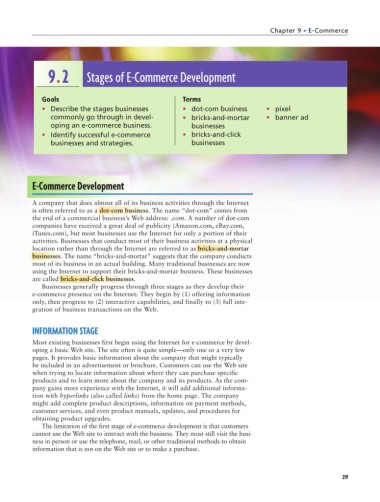Page 232 - Business Principles and Management
P. 232
Chapter 9 • E-Commerce
9.2 Stages of E-Commerce Development
Goals Terms
• Describe the stages businesses • dot-com business • pixel
commonly go through in devel- • bricks-and-mortar • banner ad
oping an e-commerce business. businesses
• Identify successful e-commerce • bricks-and-click
businesses and strategies. businesses
E-Commerce Development
A company that does almost all of its business activities through the Internet
is often referred to as a dot-com business. The name “dot-com” comes from
the end of a commercial business’s Web address: .com. A number of dot-com
companies have received a great deal of publicity (Amazon.com, eBay.com,
iTunes.com), but most businesses use the Internet for only a portion of their
activities. Businesses that conduct most of their business activities at a physical
location rather than through the Internet are referred to as bricks-and-mortar
businesses. The name “bricks-and-mortar” suggests that the company conducts
most of its business in an actual building. Many traditional businesses are now
using the Internet to support their bricks-and-mortar business. These businesses
are called bricks-and-click businesses.
Businesses generally progress through three stages as they develop their
e-commerce presence on the Internet: They begin by (1) offering information
only, then progress to (2) interactive capabilities, and finally to (3) full inte-
gration of business transactions on the Web.
INFORMATION STAGE
Most existing businesses first begin using the Internet for e-commerce by devel-
oping a basic Web site. The site often is quite simple—only one or a very few
pages. It provides basic information about the company that might typically
be included in an advertisement or brochure. Customers can use the Web site
when trying to locate information about where they can purchase specific
products and to learn more about the company and its products. As the com-
pany gains more experience with the Internet, it will add additional informa-
tion with hyperlinks (also called links) from the home page. The company
might add complete product descriptions, information on payment methods,
customer services, and even product manuals, updates, and procedures for
obtaining product upgrades.
The limitation of the first stage of e-commerce development is that customers
cannot use the Web site to interact with the business. They must still visit the busi-
ness in person or use the telephone, mail, or other traditional methods to obtain
information that is not on the Web site or to make a purchase.
219

